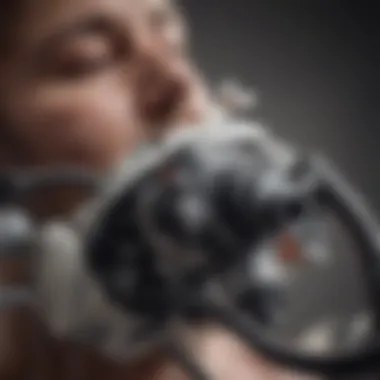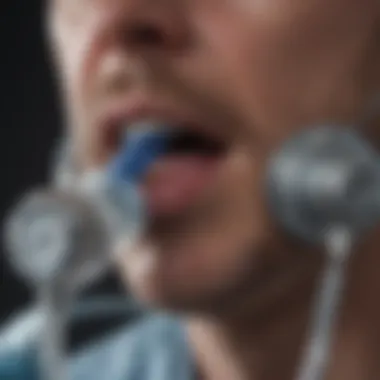Understanding BiPAP: Definition and Clinical Use


Intro
BiPAP, or Bilevel Positive Airway Pressure, serves as a pivotal tool for respiratory support in patients facing difficulties in breathing. This method is increasingly utilized in clinical settings, offering an alternative to more invasive techniques. The demand for BiPAP therapy is growing, and understanding its features, uses, and technological advancements is essential for both healthcare professionals and individuals dealing with respiratory conditions.
Key Concepts
Definition of the Main Idea
Bilevel Positive Airway Pressure therapy works by delivering two distinct levels of air pressure during inhalation and exhalation. This dual pressure system allows for enhanced comfort and usability for patients. The higher pressure assists in keeping the airways open during inhalation, while a lower pressure facilitates easier exhalation. This approach significantly improves gas exchange, which is crucial for those with compromised respiratory systems.
Overview of Scientific Principles
The underlying principle of BiPAP is based on the mechanics of pulmonary ventilation and support. Unlike Continuous Positive Airway Pressure (CPAP), which maintains a single level of pressure, BiPAP adjusts the airway pressure based on the patient's breathing pattern. This adaptability makes it particularly effective for various conditions. Additionally, BiPAP machines can monitor respiratory patterns, allowing for real-time adjustments to therapy as needed.
"BiPAP has revolutionized the management of respiratory failure by providing a non-invasive method to support patients."
"BiPAP has revolutionized the management of respiratory failure by providing a non-invasive method to support patients."
Current Research Trends
Recent Studies and Findings
Current research is focusing on the effectiveness of BiPAP in diverse clinical scenarios. Studies suggest that BiPAP therapy plays a critical role in managing conditions such as chronic obstructive pulmonary disease (COPD), obstructive sleep apnea (OSA), and even acute respiratory distress syndrome (ARDS). Researchers are increasingly looking into optimizing BiPAP settings for different populations, including pediatrics and the elderly.
Significant Breakthroughs in the Field
Recent advancements in BiPAP technology have led to improved portability and usability. Devices have become more user-friendly, with tailored interfaces that simplify the setup and monitoring processes. There are ongoing studies examining the efficacy of mobile BiPAP devices, which enhance the capacity for at-home management of chronic respiratory diseases. These breakthroughs ensure that BiPAP continues to be a relevant and effective tool in respiratory care.
Culmination
BiPAP represents a significant advancement in respiratory support, merging innovation and clinical application. Understanding its definition, functionality, and emerging research helps both healthcare professionals and patients navigate the complexities of respiratory therapy. As technology evolves, so too does the potential for better patient outcomes, making it critical to stay informed about developments in the field.
Definition of BiPAP
Understanding BiPAP is crucial for healthcare professionals and patients alike. As a non-invasive ventilation mode, BiPAP plays an important role in assisting patients suffering from various respiratory issues. Knowing the definition and functionality of BiPAP is the first step in appreciating its benefits. This section focuses on the terminology, basic principles, and historical context, providing a solid background that can enrich further discussions.
Terminology and Basics
BiPAP stands for Bilevel Positive Airway Pressure. This device delivers two levels of pressure: a higher one during inhalation and a lower one during exhalation. This dual pressure mechanism allows for easier breathing by reducing the effort required to inhale. The basic functioning of BiPAP involves its connection to a patient through a mask or nasal cannula, which then delivers pressurized air to keep the airways open. Maintaining airway patency is essential for patients with obstructive or restrictive lung conditions.
A few key terms associated with BiPAP include:
- IPAP (Inspiratory Positive Airway Pressure): This is the pressure applied when a patient inhales, providing support during the inhalation phase.
- EPAP (Expiratory Positive Airway Pressure): This is the pressure applied when the patient exhales, allowing for easier breathing and preventing airway collapse.
- Respiratory Insufficiency: A general term that refers to the inability of the respiratory system to provide sufficient oxygen or remove carbon dioxide.
Understanding these terms and mechanisms is vital for interpreting the clinical applications of BiPAP.
Historical Background
The development of BiPAP technology traces back to advancements in respiratory management. Traditional methods often relied heavily on continuous positive airway pressure (CPAP), which provided a single level of airway pressure. While effective for certain conditions like obstructive sleep apnea, this approach did not adequately address the needs of patients requiring variable pressure support.
The innovation came in the late 20th century. Researchers and manufacturers began to explore the benefits of two-pressure systems. This led to the creation of BiPAP systems, which started gaining clinical acceptance by the early 1990s. Clinical trials illustrated that BiPAP could significantly improve outcomes for patients with Chronic Obstructive Pulmonary Disease (COPD) and other respiratory failures. As evidence accumulated, BiPAP became integrated into critical care settings, changing the landscape of respiratory therapy.
BiPAP represents a significant advancement in non-invasive ventilation. Understanding this historical context aids in appreciating its current significance in medical treatments. As we continue to explore BiPAP applications and technology, this foundational knowledge will support our deeper insights.
Mechanics of BiPAP
Understanding the mechanics of BiPAP is crucial for those interested in effective respiratory care. It is a sophisticated system that offers distinct advantages over traditional methods of ventilation. The ability to assist patients with breathing issues makes it a vital tool in various medical scenarios.


How BiPAP Works
BiPAP, or Bilevel Positive Airway Pressure, functions by delivering two levels of airway pressure. This means there is a higher pressure during inhalation and a lower pressure during exhalation. The device uses sensors to monitor the patient's breathing pattern. When the patient inhales, the machine increases the air pressure, making it easier for them to take in oxygen. During exhalation, the pressure decreases, allowing for a more natural release of carbon dioxide. This method not only facilitates better gas exchange but also enhances patient comfort.
Patients may benefit from BiPAP when they experience respiratory distress. Conditions like Chronic Obstructive Pulmonary Disease (COPD) and Obesity Hypoventilation Syndrome are common indications. The ability of the machine to adjust pressures dynamically is essential. This adaptability provides necessary support during different phases of the respiratory cycle. Furthermore, BiPAP can help reduce the work of breathing, which can be vital in acute situations.
Components of a BiPAP Device
A BiPAP device consists of several critical components that all work together to ensure efficient operation. Key parts include:
- Air Compressor: This component generates the needed pressure for airflow.
- Mask: The interface through which air is delivered. It can come in various forms, such as full-face or nasal masks.
- Hoses: These connect the mask to the compressor, allowing air to flow from the machine to the patient.
- Controls and Settings: These allow healthcare providers to set parameters like inspiratory and expiratory pressures.
- Data Monitoring: Many modern devices include features to track usage and effectiveness, providing valuable information to healthcare professionals.
Understanding these components is important for proper utilization. Each section contributes to the overall functionality, ensuring that the device meets the specific needs of the patient.
In summary, grasping the mechanics of BiPAP not only facilitates better patient care but also stems from a comprehensive understanding of how such devices operate and adapt in real time.
Indications for Use
The section on Indications for Use provides crucial insights into the specific clinical scenarios where BiPAP proves to be a beneficial intervention. Understanding these indications helps healthcare professionals make informed decisions about patient care. The advantages of utilizing BiPAP in various conditions are significant, including improved oxygenation, reduced work of breathing, and enhanced patient comfort.
Chronic Obstructive Pulmonary Disease (COPD)
Chronic Obstructive Pulmonary Disease is a progressive condition characterized by airflow obstruction. Patients with COPD often face difficulties in sustaining adequate oxygenation, especially during acute exacerbations. BiPAP can assist in these situations by delivering a higher inspiratory pressure during inhalation and a lower pressure during exhalation. This mechanism eases the respiratory effort and reduces carbon dioxide levels in the bloodstream.
The use of BiPAP in COPD has been supported by clinical studies that show reduced hospital stays and lower mortality rates compared to standard oxygen therapy. It is important for medical practitioners to monitor patients closely, as titration of pressures may be necessary based on individual responses. Factors such as adherence to treatment and optimizing mask fit play a role in the successful use of BiPAP in COPD management.
Obesity Hypoventilation Syndrome
Obesity Hypoventilation Syndrome is a condition linked to severe obesity, causing an ineffective respiratory drive during sleep or rest. Patients may exhibit hypoxemia and hypercapnia due to impaired gas exchange. In this scenario, BiPAP helps ventilate the patient by improving minute ventilation, allowing for better oxygen uptake.
Clinical evidence suggests that patients with Obesity Hypoventilation Syndrome can experience significant improvements in sleep quality and daytime function when treated with BiPAP. Importantly, lifestyle changes and weight management are integral components of a comprehensive treatment plan.
Acute Respiratory Distress
Acute Respiratory Distress Syndrome (ARDS) is a serious condition characterized by rapid onset of respiratory failure and is associated with various clinical conditions, such as pneumonia or sepsis. BiPAP can serve as a supportive therapy in cases of ARDS, particularly when invasive intubation is not immediately required.
Using BiPAP in ARDS may help maintain adequate oxygenation and ventilation while the underlying condition is addressed. However, it is essential to identify criteria that qualify patients for this non-invasive method. Regular monitoring of blood gases and respiratory parameters is pivotal to ensure the effectiveness of BiPAP therapy in these patients.
In summary, recognizing the indications for BiPAP usage enhances its application in clinical settings. It empowers healthcare professionals to intervene effectively in various respiratory conditions, improving patient outcomes. BiPAP remains a vital tool in the landscape of respiratory care.
Comparison with Other Respiratory Support Methods
The topic of comparing BiPAP with other respiratory support methods is essential. As respiratory conditions become more prevalent, it is critical to understand the diverse options available in treating patients. BiPAP, or Bilevel Positive Airway Pressure, stands out due to its unique operational mechanism and flexibility. Each method of respiratory support serves distinct needs, making it imperative for healthcare professionals to evaluate these options thoroughly. This comparison highlights several notable aspects, including indications of use, patient comfort, and clinical efficacy.
BiPAP vs. CPAP
BiPAP and CPAP, or Continuous Positive Airway Pressure, are both non-invasive ventilation methods, but they function differently. CPAP delivers a constant level of pressure throughout the respiratory cycle, which helps keep airways open. This is especially beneficial for individuals with obstructive sleep apnea. On the other hand, BiPAP provides two levels of pressure: a higher pressure for inhalation and a lower pressure for exhalation. This design can offer a more comfortable experience for patients, particularly those who may struggle with expiration against constant pressure.
Benefits of BiPAP over CPAP:
- Improved comfort for patients who require different pressure levels.
- Effective for patients with additional challenges like pulmonary edema or COPD.
- Enhanced patient tolerance, which can improve long-term compliance.
However, CPAP may be more suited for simpler cases of sleep apnea, as it is often easier to use and set up. In many situations, healthcare providers make a decision based on the patient's specific condition and preferences.
BiPAP vs. Mechanical Ventilation
Mechanical ventilation is typically a more invasive form of respiratory support, requiring intubation. It offers full control over a patient's breathing process and is crucial in critical care for those unable to maintain adequate respiration. In contrast, BiPAP is non-invasive, making it an attractive option for those with mild to moderate respiratory distress.


Considerations when comparing BiPAP and mechanical ventilation:
- Invasiveness: BiPAP does not require intubation, thus reducing the risk of complications.
- Patient comfort: Many patients prefer BiPAP due to its non-invasive nature.
- Indications for use: BiPAP is often used as a first-line intervention in acute exacerbations of respiratory failure, while mechanical ventilation may be reserved for severe cases.
Ultimately, the choice between BiPAP and mechanical ventilation depends on the patient's clinical picture, severity of respiratory failure, and the desired outcomes of therapy.
The careful evaluation of the method of respiratory support can greatly influence patient outcomes. Understanding the distinctions among these methods allows healthcare providers to tailor interventions effectively.
The careful evaluation of the method of respiratory support can greatly influence patient outcomes. Understanding the distinctions among these methods allows healthcare providers to tailor interventions effectively.
This deeper insight into BiPAP compared to other respiratory methods lays the groundwork for more informed decisions regarding patient care.
Patient Experience and Compliance
The role of patient experience and compliance is crucial in the context of BiPAP usage. Successful management of respiratory conditions depends not just on the technology itself but also on how well patients adapt to and maintain their use of BiPAP therapy. Understanding the dynamics of these factors can significantly influence treatment outcomes and overall health.
Initial Adaptation
When starting on BiPAP therapy, patients often face a significant adjustment period. This time is marked by the necessity to become familiar with the device. At first, the sensation of having air pushed into the lungs can feel uncomfortable or unnatural. For some individuals, high-pressure air can cause discomfort in nasal passages or lead to feelings of claustrophobia due to the mask.
Healthcare providers play an essential role during this stage. Comprehensive education about the device, including its benefits, can promote positive initial experiences. Simple tips can ease this transition:
- Gradually increase usage time.
- Practice with the device while awake.
- Seek adjustments in mask fit to enhance comfort.
Encouragement and ongoing support can help ease patients through the adaptation phase, making them more likely to comply with long-term usage.
Long-Term Compliance Challenges
While initial adaptation is vital, maintaining long-term compliance can present its own set of challenges. Many patients exhibit a drop-off in regular use of BiPAP after the initial phase. The reasons for this decline can vary greatly. Common factors include discomfort with the mask, noisy machinery, or overall fatigue associated with chronic illness.
To address these challenges, ongoing patient education and follow-up are necessary. Strategies to enhance long-term compliance include:
- Regular follow-ups with healthcare providers to adjust pressure settings and mask options.
- Incorporating patient feedback to improve comfort.
- Reassessing the patient's progress and providing motivation.
Mental health support might also be required, as feelings of anxiety or depression can further complicate compliance.
Maintaining a consistent dialogue between patient and healthcare provider is crucial for addressing concerns and fostering commitment in long-term BiPAP usage.
Maintaining a consistent dialogue between patient and healthcare provider is crucial for addressing concerns and fostering commitment in long-term BiPAP usage.
In summary, patient experience and compliance are fundamental in making BiPAP therapy effective. By focusing on adaptation strategies and addressing long-term challenges, healthcare professionals can significantly improve patient outcomes and overall satisfaction with treatment.
Technological Advances in BiPAP Devices
Technological advances in BiPAP devices have markedly enhanced their functionality and accessibility. These innovations are critical to improving patient outcomes and experiences. As respiratory care evolves, the importance of continuous improvement in BiPAP technology cannot be overstated. Various advancements bring significant benefits, making the devices more user-friendly and effective.
Developments in Portability
One of the most notable advances in BiPAP technology is the focus on portability. Many new models are designed to be lightweight and compact, allowing for more freedom for the patient. Emergency situations often require quick transport, and improved portability facilitates immediate care where needed.
The inclusion of rechargeable batteries ensures that devices can be used outside the typical clinical settings, such as during travel or at home. This is particularly advantageous for patients who may require BiPAP support overnight or during long journeys. Enhanced mobility also allows healthcare professionals to utilize BiPAP equipment in diverse environments, thus expanding its applications in various health scenarios.
Smart Technologies and Monitoring
Another significant advancement in BiPAP devices is the integration of smart technologies and monitoring systems. Many modern BiPAP units incorporate software that tracks usage patterns, patient compliance, and even adjusts pressure settings automatically.
Such monitoring provides critical data for healthcare providers, enabling them to tailor treatments more effectively. The data collected from these devices often allows for real-time feedback, helping patients to adhere to their therapy. Moreover, some devices can connect to smartphones or medical databases, aligning with telemedicine practices. This facilitates communication between patients and healthcare providers, ensuring timely interventions if issues arise.


"Continued improvement in BiPAP technology represents a significant stride forward in respiratory care, enhancing both efficacy and patient quality of life."
"Continued improvement in BiPAP technology represents a significant stride forward in respiratory care, enhancing both efficacy and patient quality of life."
Clinical Guidelines for BiPAP Usage
Clinical guidelines for BiPAP usage provide essential frameworks for healthcare practitioners to ensure safe and effective treatment for patients requiring non-invasive ventilation. These guidelines encompass various elements including patient assessment, indication for therapy, and ongoing monitoring. Proper adherence to these guidelines can significantly enhance patient outcomes and satisfaction.
Assessing Suitability
A thorough assessment is vital when determining a patient's suitability for BiPAP therapy. Practitioners should consider several factors:
- Clinical Indicators: Assess the severity of the patient’s respiratory condition. BiPAP is effective for conditions like Chronic Obstructive Pulmonary Disease (COPD) and Obesity Hypoventilation Syndrome.
- Physiological Factors: Review the patient’s overall health, age, and comorbidities. Some patients may not tolerate BiPAP well due to other health issues.
- Patient History: Gather a complete medical history, including past ventilatory support methods. This data assists in predicting potential challenges.
- Physical Examination: Evaluate the patient's respiratory mechanics. Observe for signs of respiratory distress, which may necessitate immediate intervention.
Careful analysis of these aspects helps clinicians tailor BiPAP therapy to meet individual patient needs.
Patient Education and Support
Educating patients about BiPAP therapy is crucial for enhancing compliance and comfort. Patients must understand:
- How BiPAP Works: Providing a clear explanation of Bilevel Positive Airway Pressure and its benefits can demystify the device.
- Expected Outcomes: Discussing the possible improvements in respiratory function and quality of life encourages patient engagement.
- Device Familiarization: Demonstrating how to use the BiPAP device can ease anxiety. This includes adjusting settings and understanding mask fitting.
Moreover, offering psychological and emotional support throughout the process is essential. Addressing fears and misconceptions about the device leads to better adaptability and long-term use.
In summary, patient education is not merely informative but a vital aspect of successful BiPAP implementation. Healthcare professionals should ensure that patients feel supported throughout their treatment journey.
Future Directions in BiPAP Research
The advancement of BiPAP technology has significantly transformed the landscape of respiratory care. As we look forward, the importance of future directions in this field cannot be overstated. Continuing research and development in BiPAP systems promise to enhance their effectiveness, usability, and overall patient outcomes. Understanding these future directions is crucial for both healthcare professionals and patients alike as it may lead to improved treatment plans and innovations that could make a meaningful difference in clinical practice.
Emerging Technologies
Emerging technologies in BiPAP devices are set to redefine patient care. This includes the integration of artificial intelligence and machine learning algorithms that allow real-time data monitoring and analysis. Such technologies can provide healthcare providers with immediate insights into a patient’s condition. For instance, devices equipped with AI can learn individual patient patterns and adjust settings automatically to optimize ventilation support.
Another area of technological evolution is in connectivity. BiPAP devices are increasingly incorporating features that allow them to connect seamlessly to smartphone apps and other digital platforms. This connectivity enables patients to track their usage and respiratory status right from their phones.
The growing trend of miniaturization in medical devices is also notable. Portable BiPAP machines are becoming more efficient and smaller in size. This change is particularly beneficial for patients who need to maintain treatment while on the go. Compact devices that maintain performance are expected to improve adherence rates and ultimately lead to better health outcomes.
Potential New Applications
As BiPAP technology progresses, it is essential to consider potential new applications of therapies that utilize this methodology. One area of exploration is its application in patients with sleep-related breathing disorders. While BiPAP has primarily been used for conditions like COPD and acute respiratory distress, there is potential for its usage in managing sleep apnea. Researchers are investigating how BiPAP can provide alternative ventilation support during sleep.
Moreover, BiPAP technology may be adapted for use in emergency settings. Rapid-response units can benefit from portable BiPAP systems that can offer immediate respiratory support. This application could improve patient outcomes, especially in critical situations where time is of the essence.
Another promising avenue involves the pediatric population. There is ongoing research to develop BiPAP devices tailored for infants and children who require respiratory assistance. Tailoring settings and specialized interfaces can make BiPAP therapy suitable for younger patients, where traditional methods may be less effective.
End
The conclusion section of this article synthesizes the key elements discussed concerning BiPAP, emphasizing its operational significance in respiratory care. The various aspects of BiPAP technology, its mechanics, indications for use, and patient experience coalesce to form a thorough understanding of its clinical utility.
Summary of Findings
The exploration of BiPAP technology reveals several critical findings:
- Definition and Functionality: BiPAP stands for Bilevel Positive Airway Pressure. This method provides two levels of pressure during inhalation and exhalation, which can significantly aid patients with respiratory failure or conditions requiring ventilatory assistance.
- Mechanics and Usage: The device comprises several components, including a mask, tubing, and the BiPAP machine itself. By delivering tailored air pressure, it enhances oxygenation and ventilation capacity for individuals suffering from various pulmonary disorders.
- Indications: BiPAP is specifically indicated for conditions like Chronic Obstructive Pulmonary Disease (COPD), Obesity Hypoventilation Syndrome, and Acute Respiratory Distress. These indications ensure that patients receive appropriate support based on their unique needs.
- Patient Interaction: Initial adaptation to BiPAP can be challenging for patients. However, understanding these challenges and formulating strategies for long-term compliance can improve overall patient outcomes.
Implications for Patient Care
The implications of BiPAP technology in patient care can be substantial, particularly in enhancing the quality of life for those with chronic respiratory conditions. Key considerations include:
- Tailored Therapy: The ability to customize pressure settings allows healthcare providers to offer individualized treatment tailored to each patient’s respiratory needs, improving efficacy.
- Quality of Life: Many patients report significant improvements in symptoms such as breathlessness and fatigue, which can enhance their overall quality of life and ability to engage in daily activities.
- Educational Needs: There remains a critical requirement for educating both patients and caregivers about BiPAP technology. Understanding its function and proper use is paramount in ensuring compliance and maximizing therapeutic benefits.
In summary, BiPAP serves a vital role in modern respiratory care, addressing both acute and chronic conditions. A thorough understanding of this technology, along with appropriate clinical guidelines, can bridge the gap between technology and patient-centric care.







